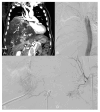Preoperative Embolization in the Management of Giant Thoracic Tumors: A Case Series
- PMID: 39452527
- PMCID: PMC11508663
- DOI: 10.3390/jpm14101019
Preoperative Embolization in the Management of Giant Thoracic Tumors: A Case Series
Abstract
Objectives: The aim of this paper is to describe our experience in the embolization of hypervascular giant thoracic tumors before surgical excision. Methods: A single-center retrospective review of five trans-arterial preoperative embolization procedures executed between October 2020 and July 2024. Patients' demographics, anatomical aspects, feasibility, technique, and outcomes were reviewed. Results: In all cases, accurate targeting and safe embolization was achieved, with satisfactory devascularization evaluated with post-procedural angiography and with minimal blood loss during subsequent surgical operation. Conclusions: In our experience, preoperative embolization of giant thoracic masses has been technically feasible, safe, and effective in reducing tumor vascularization, thus facilitating surgical treatment. This approach should be evaluated as an option, especially in patients with hypervascular thoracic tumors.
Keywords: computed tomography; digital subtraction angiography; giant thoracic tumors; preoperative embolization; transcatheter arterial embolization.
Conflict of interest statement
The authors declare no conflicts of interest.
Figures








References
-
- Darbari A., Dutt B., Kumar A., Goswami A.G., Starlet A.R. A retrospective observational study over surgical management of giant thoracic tumours: Horrendous but manageable. Cardiothorac. Surg. 2023;31:15. doi: 10.1186/s43057-023-00106-w. - DOI
Publication types
LinkOut - more resources
Full Text Sources

